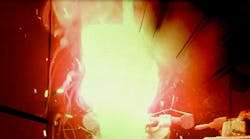Researchers at the U.S. Army Research Laboratory and the Ludwig Maximilian University in Munich developed an environmentally friendly red light flare for use in military signaling devices and for firework displays.
It uses lithium-based chemistry to create a bright red light of high purity and color quality while avoiding environmentally objectionable materials such as strontium and chlorinated organic materials, which are both commonly used in red fireworks and flares.
The new formulation is based on a non-hygroscopic dilithium nitrogen-rich salt that serves as both oxidizer and red colorant. To create the bright red light, researchers used magnesium and hexamine as the fuels; nitrocellulose as an epoxy binder system; and a lithium-based high-nitrogen salt, which serves as both oxidizer and colorant. When burned, this formulation creates a relatively cool-burning flame while throwing off suitable quantities of red-light-emitting atomic lithium. This represents the first red-light-emitting compound based on lithium that does not contain any perchlorates, halogenated materials, or strontium-based materials.
Historically, red fireworks contained powdered metal fuels such as magnesium and aluminum, strontium nitrate, and perchlorate oxidizers, as well as carbon-based chlorinated organic materials such as poly (vinyl) chloride. Today, perchlorates, chlorinated organic materials, and strontium-based materials are falling out of favor from an environmental perspective and face increasing scrutiny and regulation from the EPA.
The agency reported that strontium is potentially harmful to human health, specifically that it replaces calcium in the bone, interferes with bone strength, and thus affects the skeletal development of children and adolescents. In 2014, the EPA began regulating strontium in drinking water. Strontium has been detected in 99% of all public U.S. water systems and at levels of concern in 7% of them. U.S. military training grounds were not included in the study, but they may show elevated concentrations of strontium as well, given the presence of strontium in currently used red flares and signaling pyrotechnics.
The next step in this research is to make the strontium- and halogen-free red flare the team developed brighter. The current and future formulations may draw interest from the civilian fireworks and military pyrotechnics communities.

